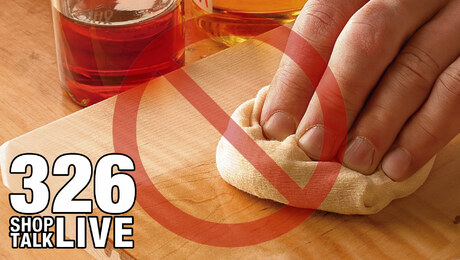STL 160: Beginner Mistakes
Plus, dealing with a warped panel, keeping tabletops from moving, the safety of spalted wood, and a snippet from our interview with Brian BoggsShop Talk listeners, get $50 off your Fine Woodworking Live 2018 registration with the coupon code “SHOPTALK”
Question 1:
Do you prefer coping saws or fret saws? I’d like to buy saw for cleaning up dovetail waste. My research tells me that fret saws cut slow but you can do it in one motion whereas coping saws cut fast, but you need to make two cuts for waste. -Stan
- Tool Test: Coping Saws by Chris Gochnour #238–Jan/Feb 2014 Issue
- Half-Blind Dovetails in Half the Time by Stephen Hammer #219–May/June 2011 Issue
- Video – Half-Blind Dovetails in Half the Time
Segment: What’s the most common mistake you see new woodworkers make?
- Matt – Not paying attention to the wood they use
- Ben – Not having enough patience
- Mike – Creating too many stumbling blocks for themselves
Question 2:
I started building Christian Becksvoort’s letter tray from issue #264. Instead of doing it in pine I made the box sides in walnut and the base in quartersawn pine with a few coats of marigold yellow milk paint. When I painted the base, it warped quite a bit. Luckily, I was able to force it into the grooves, but once I cut out the front opening it pulled up the front corners so they don’t sit flat any longer. Will painting the bottom of the panel reverse this. Unfortunately, it is now glued in so replacing the panel is out of the question. -James
An interview with Brian Boggs
You can listen to the full interview here.
Question 3:
I have a question about keeping table tops from moving. As I understand it, tabletops need to be secured with some sort of batten or other means across the grain to keep it flat over time. I’ve seen a number of examples where a leg is put directly in to a tabletop similar to Windsor joinery with no means to keep the top flat. Does this not ignore the rule, shouldn’t there be some effort to keep a top flat or is this not a concern if the slab is below a certain size? -Chris
Question 4:
I’ve recently picked up a sloyd knife and gouge and would like to turn some scraps into kitchen utensils. Should I have any concern with using the spalted wood for this? I know I’m being paranoid, but I’ve grown fond of my family and don’t want to kill them. -Josh
- Spalt Your Own Lumber by Seri Robinson #199–July/Aug 2008 Issue
- Spalt Your Own Lumber: Health problems associated with spalted wood, and debunking myths
Here is Seri Robinson’s full reply to this question:
“There is nothing inherently dangerous about spalted wood. Often, however, woodworkers are confused between mold (which is not spalting), and spalted wood. Mold is a problem for many people, especially those with allergies and compromised immune systems. Spalting is a problem for no one. But wet wood both spalts and molds (and all wood has mold on it, whether or not you can see it). So I make the blanket statement noted below mostly to just get people to think about what they’re working with, not because spalted wood is inherently dangerous. People with compromised immune systems shouldn’t be working with wood, period.
There is no issue in eating with a spalted wood spoon, outside of the spoon potentially breaking. Zone lines are completely inert, and the blue-green stain of Chlorociboria is also quite safe. The red stain of Scytalidium cuboideum we have some questions on, but no one would be able to carve a spoon from red-stained wood and have it be useable, so I think we’re pretty safe there. As a note, the red pigment in boxelder has never been really tested, so I would advise against boxelder wood for food objects (noting that boxelder is not spalting, of course).” – Seri Robinson
Question 5:
I’m making a toy train set for my young nephew. Kids tend to put things in their mouth and I was worried not all finishes might not be safe. What are your go-to kid safe finishes? -Drew
Listener Comments:
Very informative by MikeGit – I love the show, but I have one complaint. When you talk about your favorite tools, I often want to buy them and sometimes I do. My wife is not happy with you guys.
From the show notes page, RE STL159:
I sharpen my 1/2″ 3tpi bi-metal blades at least twice before they lose too much set. Takes about 15 minutes for a 105″ blade. Dremel + rotary diamond hone intended for chainsaws. -RWYoung
 |
 |
 |
| Ben Strano Web Producer |
Mike Pekovich Creative Director |
Matt Kenney Special Projects Editor |
Every two weeks, a team of Fine Woodworking staffers answers questions from readers on Shop Talk Live, Fine Woodworking‘s biweekly podcast. Send your woodworking questions to [email protected] for consideration in the regular broadcast! Our continued existence relies upon listener support. So if you enjoy the show, be sure to leave us a five-star rating and maybe even a nice comment on our iTunes page.




















Log in or create an account to post a comment.
Sign up Log in